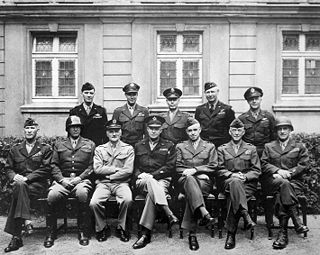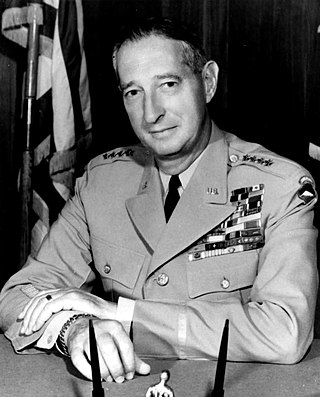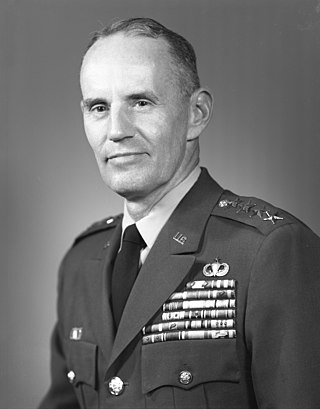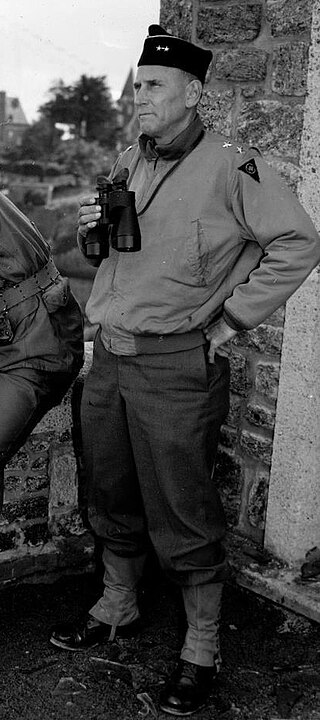Related Research Articles

The European Theater of Operations, United States Army (ETOUSA) was a Theater of Operations responsible for directing United States Army operations throughout the European theatre of World War II, from 1942 to 1945. It commanded Army Ground Forces (AGF), United States Army Air Forces (USAAF), and Army Service Forces (ASF) operations north of Italy and the Mediterranean coast. It was bordered to the south by the North African Theater of Operations, United States Army (NATOUSA), which later became the Mediterranean Theater of Operations, United States Army (MTOUSA).

Mark Wayne Clark was a United States Army officer who saw service during World War I, World War II, and the Korean War. He was the youngest four-star general in the US Army during World War II.

The 13th Airborne Division was an airborne forces formation of division-size of the United States Army that was active during World War II. The division was commanded for most of its existence by Major General Elbridge G. Chapman. It was officially activated in the United States in August 1943 at Fort Bragg in North Carolina, remaining active until February 1946, however it never saw combat.

The 91st Infantry Division (famously nicknamed as the "Wild West Division" with a "Fir Tree" as its Division insignia to symbolize its traditional home of the Far West) is an infantry division of the United States Army that fought in World War I and World War II. From 1946 until 2008, it was part of the United States Army Reserve. It was briefly inactivated from 2008 until 2010 when it was elevated back to a division size element as the 91st Training Division (Operations).

The 96th Sustainment Brigade, is a combat service support formation of the United States Army Reserve. It traces its history to the 96th Infantry Division which served in the Asia-Pacific theater during World War II. Effective 17 September 2008, the unit became the 96th Sustainment Brigade, with its headquarters located at Fort Douglas, Salt Lake City, Utah.

The 98th Infantry Division ("Iroquois") was a unit of the United States Army in the closing months of World War I and during World War II. The unit is now one of the U.S. Army Reserve's training divisions, officially known as the 98th Training Division. The 98th Training Division's current primary mission is to conduct Initial Entry Training (IET) for new soldiers. It is one of three training divisions subordinate to the 108th Training Command (IET).

Bruce Palmer Jr. was a general in the United States Army. He commanded the XVIII Airborne Corps during Operation Power Pack, the II Field Force, Vietnam during the Vietnam War, and was acting Chief of Staff of the United States Army from July to October 1972.
The 366th Infantry Regiment was an all African American (segregated) unit of the United States Army that served in both World War I and World War II. In the latter war, the unit was exceptional for having all black officers as well as troops. The U.S. military did not desegregate until after World War II. During the war, for most of the segregated units, all field grade and most of the company grade officers were white.
Benjamin Lewis Salomon was a United States Army dentist during World War II, assigned as a front-line surgeon. During the Battle of Saipan, when the Japanese started overrunning his hospital, he stood a rear-guard action in which he had no hope of personal survival, allowing the safe evacuation of the wounded, killing as many as 98 enemy troops before being killed himself. In 2002, Salomon posthumously received the Medal of Honor. He is one of only three dental officers to have received the medal, the others being Alexander Gordon Lyle and Weedon Osborne.

Major General Robert Chauncey Macon was a senior United States Army officer who commanded the 7th Infantry Regiment and the 83rd Infantry Division during World War II in Western Europe and later served as military attaché in Moscow.

General Wade Hampton Haislip was a senior United States Army officer who served in both World War I and World War II, where he led XV Corps on the Western Front from 1944 to 1945. He later became a four-star general, serving as Vice Chief of Staff of the United States Army (VCSA) from 1949 to 1951.
This list of United States Army divisions is divided into three eras: 1911–1917, 1917–1941, and 1941–present. These eras represent the major evolutions of army division structure. The 1911–1917 era lists divisions raised during the Army's first attempts at modernizing the division, prior to the authorization of permanent divisions, and the 1917–1941 era lists the first permanent divisions, prior to advent of specialized divisions. The 1941–present era lists all of the divisions organized, raised, or authorized since then.

Major General Ralph Corbett Smith was a senior officer of the United States Army. After receiving early training as a pilot from Orville Wright he served Brigadier General John J. Pershing's army against Pancho Villa, was decorated for bravery in World War I and commanded the 27th Infantry Division in combat in the Pacific War in World War II. At his death Smith was the oldest surviving general officer of the Army.

Robert Nicholas Young was a lieutenant general in the United States Army. He gained prominence in the 1950s as the commander of the 2nd Infantry Division during the Korean War and as commander of the Sixth United States Army.

Major General Vyvyan Evelegh, was a senior officer of the British Army during the Second World War, commanding the 78th Infantry Division and the 6th Armoured Division in Tunisia and Italy.

Major General Lloyd Davidson Brown was a senior United States Army officer who served in both World War I and World War II. During the latter, he commanded the 28th Infantry Division, including during the Battle of Normandy in mid-1944.

Haydon LeMaire Boatner was a major general in the United States Army who served in World War II and the Korean War.

The 387th Infantry Division was an infantry division of the German Army during the Second World War, active from 1942 to 1944. It saw active service on the Eastern Front and was destroyed in fighting in Romania in August 1944.

The 376th Infantry Division was an infantry division of the German Army during World War II, active from 1942 to 1944 in two separate instances.

Louis A. Craig was a career officer in the United States Army. He attained the rank of major general, and served in both World War I and World War II. Craig served as a corps and division commander during World War II and was the Inspector General of the Army from 1948 to 1952.
References
- ↑ "98th Infantry Division". US Army Center of Military History. Retrieved 7 June 2020.
- ↑ Philip A. Crowl (1993). War in the Pacific: Campaign in the Marianas. United States Army in World War II Series. US Government Printing Office. p. 225. ISBN 978-0-16-061312-8.